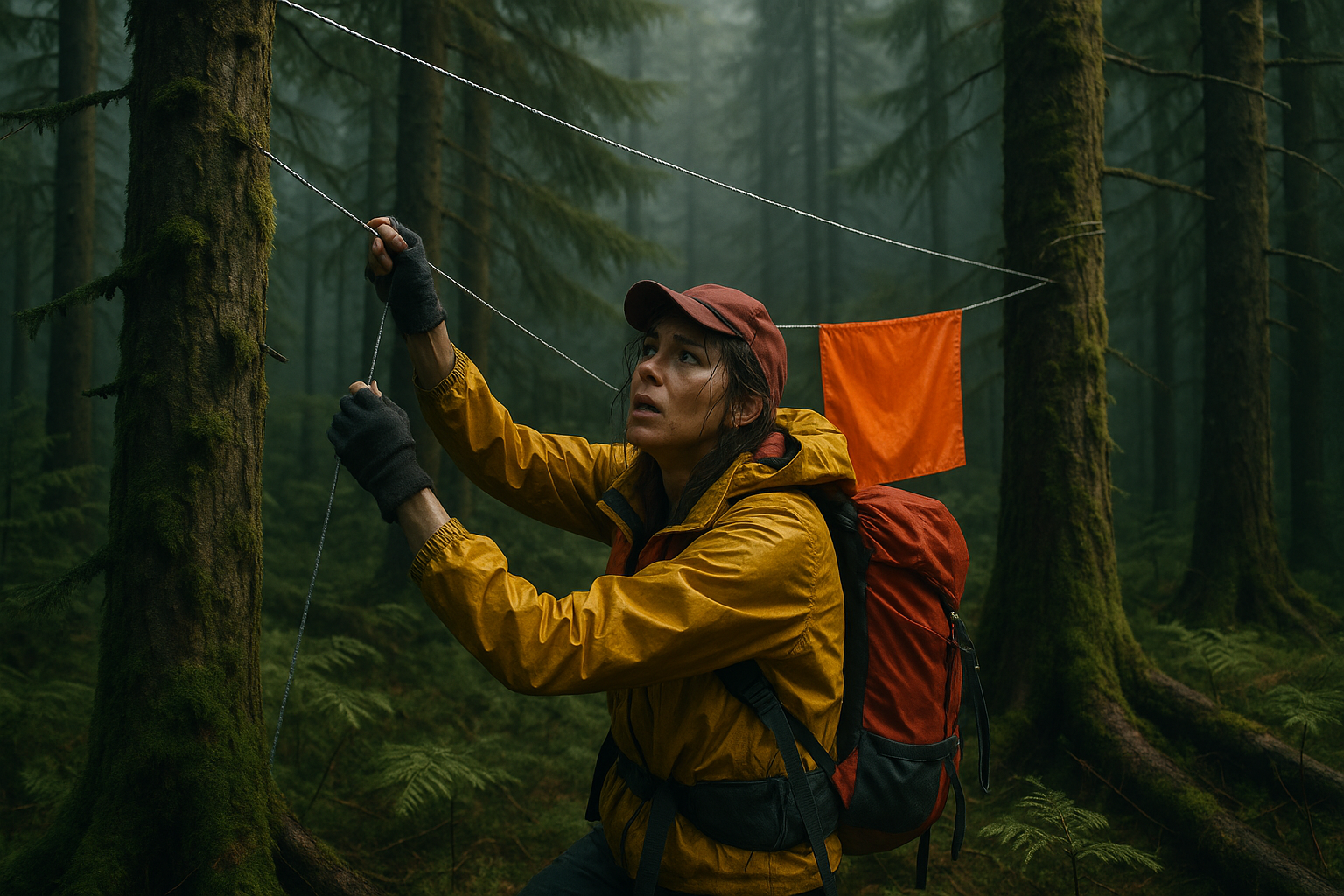You step off the trail to check a distant rustle—just for a moment. But the forest swallows you whole. The canopy above blocks the sky. Your compass readings spin wildly, and panic sets in. No signal, no sound of rescue teams. You’re trapped in a maze of trees, every direction identical.
In this life-or-death survival scenario, shouting for help won’t cut it. Ground signals are useless in dense forests. The only way to be found is to stand out—from above. This is where your reflective clothesline and bright gear transform into your lifeline.
This guide will teach you how to rig a makeshift, high-visibility signal banner using simple items you already carry—so that search planes, drones, or helicopters can spot you, even through thick foliage.
🌲 Why a High-Visibility Aerial Signal Is Critical
- In dense forests, ground signals like fires or noises get lost in the canopy.
- Rescuers depend on aerial searches using helicopters, drones, or planes.
- Without a bright, moving, reflective signal, you risk fading into the shadows.
🏕️ Gear You Need (Likely Already in Your Pack)
✅ Reflective clothesline or paracord – Often part of your gear for drying clothes or rigging tarps.
✅ Bright gear – Rain jackets, tarps, Mylar blankets, or even neon plastic bags.
✅ Metallic items – Signal mirrors, pot lids, or emergency foil reflectors.
✅ Optional – Glow sticks or mini LED lights for nighttime visibility.
🔶 Step-by-Step: Building a Life-Saving Signal Banner
🪢 1. Find or Create an Elevated Line Point
- Search for two trees or branches spaced apart, ideally near an open or partially open canopy gap.
- No trees? Use a trekking pole, paddle, or a long branch tied to a rock as an improvised pole.
- Tie the reflective clothesline tautly between these points, aiming to get it as high as possible (think: a makeshift aerial clothesline).
🪢 2. Prepare Your Bright Gear for Maximum Contrast
- Bright rain jackets, tarps, or even neon tent flys are ideal.
- Cut or tear Mylar emergency blankets into strips to catch and reflect sunlight.
- Secure reflective or metallic items (like pot lids) for extra visual impact.
🪢 3. Attach Gear to the Line in a Banner Formation
- Tie or clip items along the clothesline, spacing them to create a large, contrasting flag visible from above.
- If possible, allow pieces to flutter in the breeze—it’s motion that catches the eye.
- For added weight and stability, tie the bottom corners to rocks or logs.
🪢 4. Angle and Position the Banner for Best Visibility
- Angle the line toward likely flight paths or open areas.
- Position reflective elements to catch sunlight, especially during mid-morning or afternoon when shadows shift.
- In flat or dense areas, use multiple lines at different heights and angles to maximize visibility.
🪢 5. Nighttime Adaptations for 24/7 Signaling
- Crack glow sticks and attach them along the clothesline for a glowing effect.
- Use LED headlamps or mini lanterns, tied to fluttering elements to create a moving light pattern.
- Shine a flashlight upwards to illuminate your banner, increasing visibility at dusk or dawn.
🔥 Improvised Options When Gear Is Scarce
If you’re missing key items:
- Use shoelaces, tent guylines, or even backpack straps in place of clothesline.
- Tear up colorful trash, like snack wrappers or grocery bags, to add visual contrast.
- Polish the bottom of a pot with sand or dirt for an improvised mirror signal.
- Hang your emergency blanket from a single tree or tall branch as a standalone reflector.
🚨 Field Story: Saved by a Makeshift Sky Signal
A solo trekker lost in the dense Appalachian backcountry used this technique. With no cell signal, he rigged a clothesline between two tall pines, attaching his neon orange jacket, a torn emergency blanket, and a reflective pot lid. His makeshift signal was spotted by a drone after he’d been missing for two days. His preparedness—and ingenuity—saved his life.
📊 Why This Method Works: A Quick Comparison
| Signal Type | Pros | Cons |
|---|---|---|
| Reflective Line Signal Banner | High-visibility, improvisable | Needs setup and some gear |
| Smoke or Fire | Quick, attention-grabbing | Limited in wet weather, risk of wildfire |
| Whistles or Yells | No gear needed, draws local attention | Ineffective at distance, no aerial reach |
| Phone or GPS | Direct SOS if coverage available | Fails when battery dies or no signal |
🛠️ Survivalist Tips for Mastering This Technique
- Practice at home: Learn to set up a clothesline signal quickly using your gear.
- Choose bright, contrasting gear: The more it stands out, the better.
- Think movement: Fluttering pieces are more visible than static ones.
- Work with nature: Position the banner to catch the wind and sun.
- Multiple banners, multiple heights: Don’t rely on just one signal.
🎒 Essential Gear to Pack (Available on Amazon)
✅ Reflective Paracord 550 – Strong, light, and high-visibility.
✅ Sea to Summit Lite Line Clothesline – Compact and versatile for signaling.
✅ Emergency Mylar Blanket – Lightweight, reflective, life-saving.
✅ Mini LED Lantern or Glow Sticks – Nighttime visibility essential.
✅ Carabiners or Clips – Quick and secure attachments.
🔥 Bonus: The Flicker-Flag Hack
For extra attention, thread the clothesline through a lightweight stick, balancing it like a seesaw. As wind hits, the stick rotates, creating a flickering motion that’s far more noticeable from the air.
🚁 Conclusion: When Every Second Counts, Be Seen
Being lost deep in the forest isn’t just about waiting—it’s about fighting to be seen. A makeshift signal banner using reflective clothesline and bright gear isn’t a gimmick. It’s a tested, lifesaving tool that leverages your resourcefulness when all else fails.
The sky can’t help if it can’t see you. Rig your signal banner. Stay alive. And be ready for rescue.

